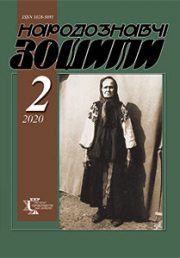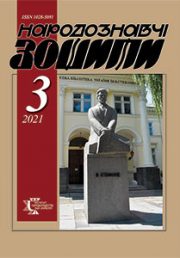The Ethnology Notebooks. 2020. № 5 (155), 1097—1107
UDK. 7.46.3:[27-544.8—051:27—312.3](477)”15/17″
DOI https://doi.org/10.15407/nz2020.05.1097
Shyroka Oksana
- PhD candidate,
- Lviv National Academy of Arts,
- Kubiiovycha Street, 38,
- 79011, Lviv, Ukraine
- Contacts:e-mail: shirokaoksana@gmail.com
Abstract. Introduction. The subject of research is the peculiarities of the image of three wise magicians in the Ukrainian iconography of the Nativity of Christ and the cycles of the Akathists of the Mother of God of the XVI—XVIII centuries.
The purpose of the study is to conduct a comparative analysis of the iconography of the three wise magicians in the Ukrainian art of the XVI—XVIII centuries.
The object of research is the image of three magicians in compositions: Christmas; Worship of the Magic; arrival, worship and return of the magicians to Babylon cycles of the Akathist of the Mother of God in Ukrainian art of the XVI—XVIII centuries.
Relevance of the chosen topic. Images of three magi in the iconography of the Nativity of Christ and Ukrainian cycles of the Akathist to the Mother of God XVI – XVIII centuries have never been an independent object of study by scientists. Considering the change in the interpretation of the images of the Magi, it is advisable to determine the features and sources of transformation of this iconography in the Ukrainian art of the XVI – XVIII centuries.
The methods of formal art history and historical-cultural analysis, iconography and iconology gave the opportunity to trace the changes in the interpretation of the images of the magicians in the Ukrainian art of the XVI—XVIII centuries.
Results: It is established that the sages-magicians in oriental costumes, in princely clothes, kings with turbans or crowns on their heads. The Magi became the embodiment of three ages of humanity (old man, middle-aged man, young man), three continents (Europe, Asia, Africa) and racial identity (one of the Magicians was portrayed as black).
Conclusions. The iconographic basis of the transformation of the images of the Magi in the Ukrainian art of the XVI—XVIII centuries were: 1) compositions of the Nativity of Christ of the XVI—XVII centuries; 2) iconography «Nativity of Christ with the history of childhood» (typical of the Rybotytsya painting center, 1670s—1760s); 3) iconography of holy warriors-riders (St. George, St. Boris and Gleb); 4) Murals of the Akathist of the Mother of God of the Greek, Balkan and Romanian regions of the XIV—XVI centuries; 5) Western European painting and engraving XIV—XVII centuries.
Keywords: Akathist of the Mother of God, Christmas, iconography, icon, players, mural, magi.
Received 25.09.2020
REFERENCES
- Ovsichuk, V.A., & Krvavych, D.P. (2000). The story about the icon. Lviv: Institute of Ethnology of the National Academy of Sciences of Ukraine [in Ukrainian].
- Hall, D. (1996). Dictionary of plots and symbols in art. Per. from the English A.E. Maikapar. Moscow: Kron-Press [in Russian].
- Zhayvoronok, V.V. (2006). Signs of Ukrainian ethnoculture: Dictionary-reference book (Pр. 112—113). Kyiv: Dovira [in Ukrainian].
- (2005). Patriarch Dmytriy (Yarema). Iconography of West Ukraine XII—XV centuries. Lviv: Drukarski kunshty [in Ukrainian].
- Gromova, E.B. (2005). History of the Russian iconography of Akathist. Icon «Praise of the Mother of God with Akathist» from the Assumption Cathedral of the Moscow Kremlin. Moskva: Indrik [in Russian].
- Fabritius, Ruth. (1999). Interior painting and liturgy. The controversial orthodoxy in the pictorial program of the Moldau churches Hermani Verlag Dьsseldorf [in German].
- Kosiv, R.R. (2019). Rybotychi center of church painting in the 1670s—1760s. Lviv: A. Sheptycky National museum in Lviv [in Ukrainian]
- (2010). Akathist to Virgin Mary. Prayerbook with psalter. Fourth edition. Kyiv; Kharkiv; Lviv: Swiatohorec [in Ukrainian].
- (1627). Triod’ pisna. Natsional’na biblioteka im. V. Vernads’koho. Kyiv. Kyr. 7. Kyiv: drukarnya lavry [in Cyrillic].
- (1625). Akathists of the Immaculate Conception and the sweet Jesus. Lviv National Scientific Library named after V. Stefanyk. Lviv. IV–ST. 2338. Kyiv: printig house of lavra [in Cyrillic].
- Hrotovs’kyy, Pyotr Lukash. (2009). Mural of the nave of the church of St. Onufriya in Posada Rybotytska (introductory remarks). Researches of the Fine Arts (Part 3 (27), pp. 40—69). Kyiv [in Ukrainian].
- Franko, I. (1906). To the history of the Ukrainian nativity scene of the XVIII century. Imprint from the «Notes of the Shevchenko Scientific Society» (Vol. LXXI—LXXIII). Lviv: printing house of the Shevchenko Scientific Society [in Ukrainian].
- Stasenko, V. (2003). Christ and the Virgin in woodcuts of Cyrillic books of Galicia in the XVII century: features of development and interpretation of the image. Kyiv: Print [in Ukrainian].
- (1699). Akathist with sticherons and canons. Vernadsky National Library of Ukraine. Kyiv. Kyr. 637. Lviv: printing house of Brotherhood [in Cyrillic].
- (1706). Akathists are all-weekly with sticheras and canons. Lviv: National Scientific Library named after V. Stefanyk. Lviv, ST. 2381. Kyiv: printig house of lavra [in Cyrillic].
- Lopukhin, A.P. (Ed.). (1908). Orthodox Theological Encyclopedia or Theological Encyclopedic Dictionary: in 12 vol. Carmelites — КпйнЮ: with 15 drawings. V, 754 stb. (Vol. 9). Petrograd, 1900—1911 [in Russian].
- (2005). Master Theodoric and Czech painting of the XIV century. Great artists. Their life, inspiration and creativity. Kyiv [in Russian]
- (1650). Album № 24. Piscator’s Bible. Mediorit., 1650. 283 arc. Retrieved from: http://irbis-nbuv.ua/ulib/item/UKR0007150 (Last accessed: 29.04.2020) [in Latin].
- Evangelicae Historiae Imagines (Images Of The Evangelical Gospels). Retrieved from: https://archive.org/details/EvangelicaeHistoriaeImagines/page/n15/mode/2up [in Latin]. (Last accessed: 24.04.2020).
- (1731). Akathist. Vernadsky National Library of Ukraine. Kyiv. Kyr. 99. Kyiv: printing house of lavra [in Cyrillic].







